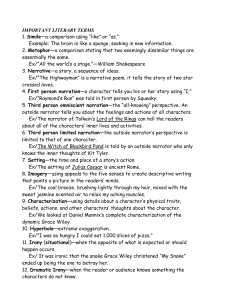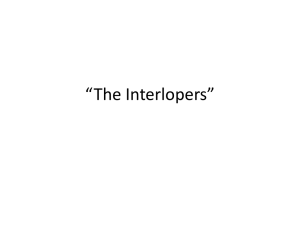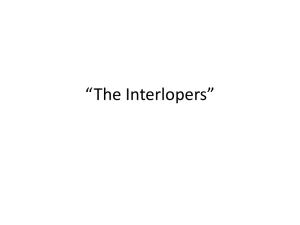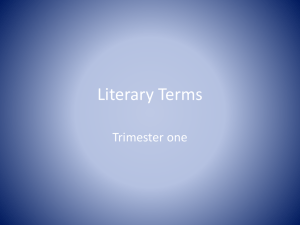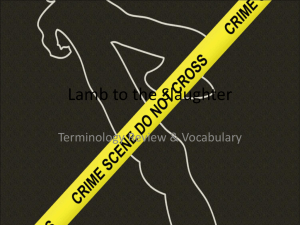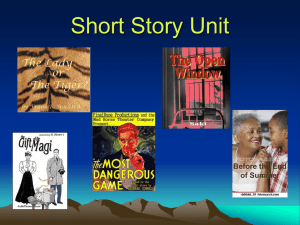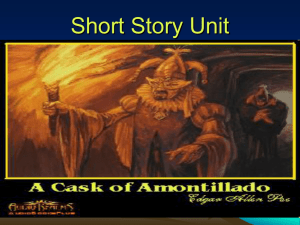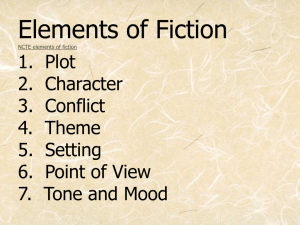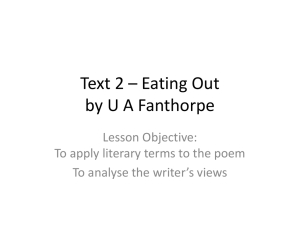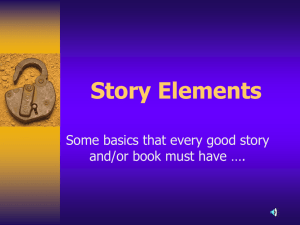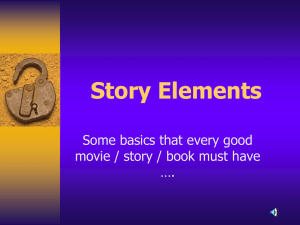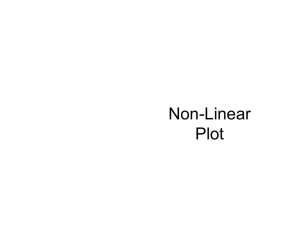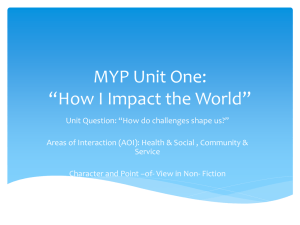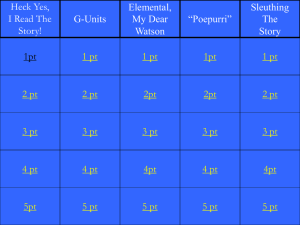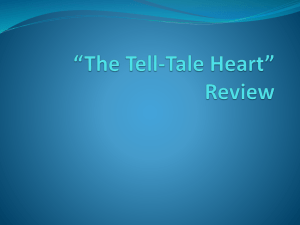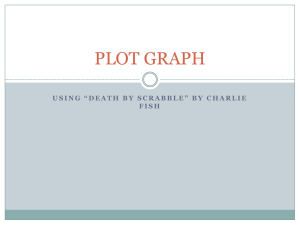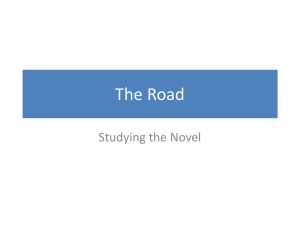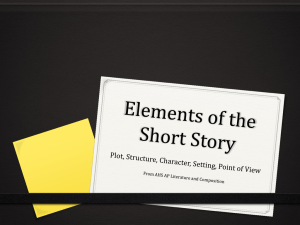Story Structure: tells how authors present the story
advertisement
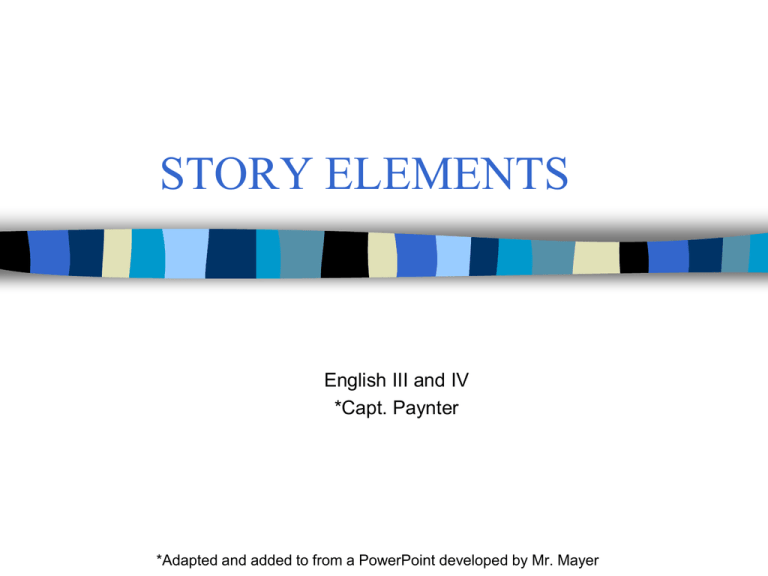
STORY ELEMENTS English III and IV *Capt. Paynter *Adapted and added to from a PowerPoint developed by Mr. Mayer Story Structure: tells how authors present the story Exposition: background about characters, setting, situation Rising Action: conflict arises, more information is learned about characters and setting Climax: when action reaches the highest point Falling Action: the story begins wrapping up, characters are dealing with whatever happened in the climax Resolution: This tells how the story concludes Climax Rising Action Exposition Falling Action Resolution Without a conflict you have no story. Types of conflict: Man vs. man—external struggle between two or more individuals Man vs. himself—internal struggle concerning emotion and decision. Man vs. nature—external struggle between man and an element of nature. Man vs. machine–-external struggle between man and non-nature. How Writers Create Setting Details: Adding details makes the story seem more believable. Sensory Imagery: Adding details that appeal to the reader’s sight, smell, taste, touch, and hearing creates a vivid picture. Point of View: This is the view from which the story is told. Who’s head are you in? Ask yourself, “Who is telling the story?” There are 3 types of point of view A- First Person 1. The narrator is recognizable by use of first person pronoun, generally "I" but sometimes "we" 2. The narrator offers one perspective 3. The narrator asks reader to take into account the character of the storyteller 4. The narrator may be a participant, a character involved in the events, or a non-participant, an observercharacter not actually involved and therefore closely resembles third person . When reading stories in the first person, we need to realize that what the narrator is recounting might not be the objective truth. We should question the trustworthiness of the accounting. B- Third Person An outside force without any clear identity tells the story [described elsewhere as like the eye of God] 1- Omniscient: Narrator moves freely about in time and space and into characters’ thoughts and feelings . The narrator knows everything about them, interprets and comments on their behavior, and even comments on the significance or meaning of the story. There are 2 kinds… B- Third Person 2 - Limited omniscient: Like omniscient, the story is told in third person, but the author tells it from the viewpoint of only one character. The author looks at events through the eyes, mind and emotions of that one character. The writer moves inside and outside the character and knows what that character sees, hears, feels, and thinks. However, nothing is revealed about the other characters except for what his chosen character knows or infers. This point of view is closer to the conditions of real life and may serve to unify the story since all details are seen through the eyes and experience of one person. 3- Objective : narrator refrains from any editorial commentary . The narrator can go anywhere, but can only record what is seen and heard. The narrator tells what happens without stating more than can be inferred from the story's action and dialogue. The narrator never discloses anything about what the characters think or feel, remaining a detached observer. Does the main character tell his own story? (first person narrator) Does a minor character tell the main character’s story? (first person observer) When the narrator is not a character in the story ask: Does the author tell what people think and explain feelings and motives? (omniscient author) Does the author simply tell the story without giving the thoughts and feelings of the characters? (author observer) Theme: A theme is a universal idea. A theme teaches a specific lesson or moral. Most stories have more than one theme. To find the theme ask: What is the story about? What is the central idea? What observation did the author make about human nature? Imagery: uses details to describe something and evoke feelings The icy hail furiously pelted my car, leaving magnificent holes in the smooth hood. The sound pierced my ears ruthlessly, as I tried to find shelter. Imagery gives you detailed pictures in your mind. Symbol: an image, character, or action that stands for an idea beyond its literal meaning Some aren’t... Some are obvious... Tone: is like the author’s “tone of voice”--it tells you their attitude towards the characters, setting, etc. “She dismally muttered that she’d always love him, even though he was gone. She’d never love again.” What’s the tone here? Irony: to intend a meaning opposite of what is expected. There are a few kinds of irony. Dramatic Irony: The audience knows something that the character does not. Situational Irony: when the opposite of what was expected happens. Dramatic Irony: You know what the farmer does not. Situational Irony: You’d expect cheetahs to run, not speed-walk. Which kind of irony is this? Which kind of irony is this? Hyperbole: an exaggerated statement used to make a strong effect “Whoa! That cookie looks like a million bucks!” Realism: The author attempts to portray life in his/her novel realistically. He/she must use details to reflect the reality that we see around us. Romanticism: The author uses his imagination to present the world to us. At times his/her view may be extremely idealistic; at other times it may reflect extreme horror. Foreshadowing: A writing technique that gives readers clues about what will happen later in the story. “As he pondered the morning, he reassured himself that he locked the door. Something kept telling him otherwise, but he pushed it out of his mind.” What might this be foreshadowing? FLASHBACK: The author interrupts the story to go back in time to add scenes or information. This helps the reader understand what is happening in the present. Protagonist: the main character in the story (good guy) Antagonist: the force against the protagonist (bad guy) Flat Character: stays the same throughout the story. Round Character: grows or changes during the story. Simile: comparing 2 things using like or as. Her hair was as soft as cotton. Metaphor: comparing 2 things without using like or as. A heavy blanket of snow fell all day long. IN REVIEW- USE ALL TO GET THIS: Exposition: background about characters, setting, situation Rising Action: conflict arises, more information is learned about characters and setting Climax: when action reaches the highest point Falling Action: the story begins wrapping up, characters are dealing with whatever happened in the climax Resolution: This tells how the story concludes What is a short story? A short story is a relatively brief fictional narrative or story written without using any rhymes of rhythms. The short story has a beginning, a middle, and an end and is composed of the following elements: Theme Plot Character Setting Point of View Brief History: The short story may be as old as man. It started with the oral traditions and later was written down. Many of their beginnings were steeped in fact, but later became embellished and became “tall tales” or “fables”. These may have not been “official”, but they have many of the elements of a short story. The accepted view among literary historians is that the short story, as we know it today, began in the early nineteenth century; that is to say, it appeared as a literary form slightly later than the novel, which is usually held to have emerged in the eighteenth century. TODAY READ “The Rocking Horse Winner” Literature book (1006-1021). ANSWER the questions on the worksheet. TURN-IN sheet and be prepared to discuss the story and author tomorrow.

